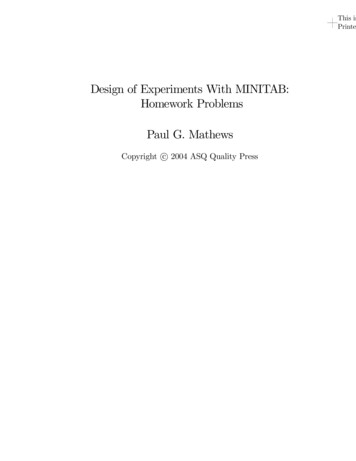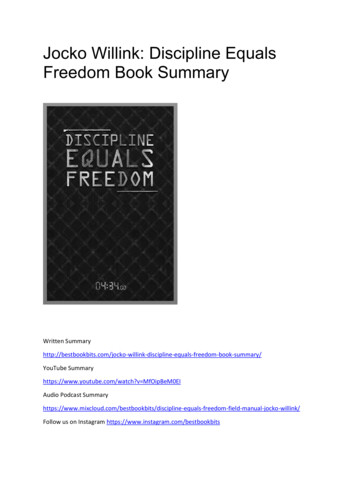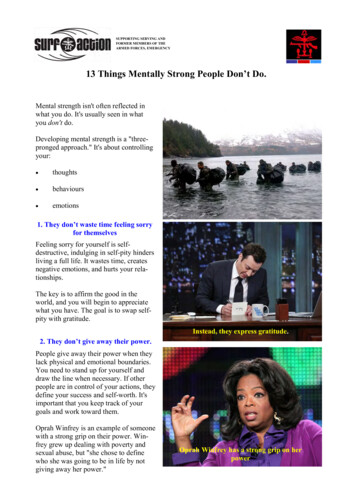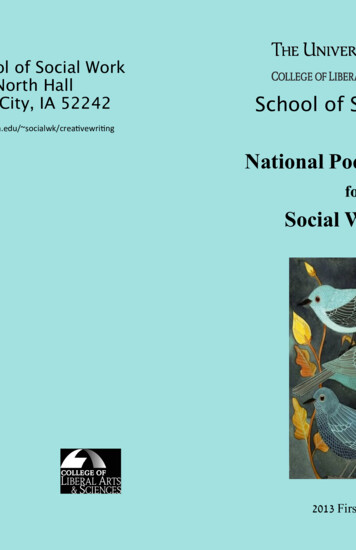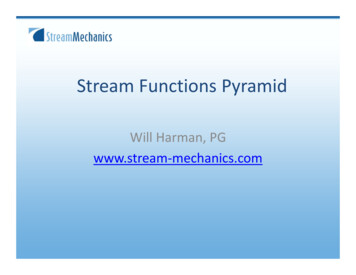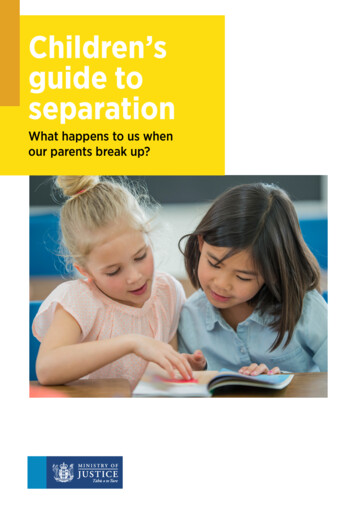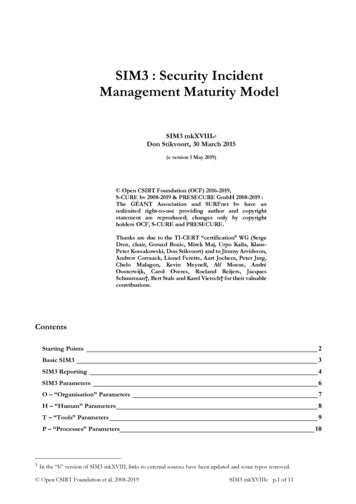
Transcription
SIM3 : Security IncidentManagement Maturity ModelSIM3 mkXVIIIc1Don Stikvoort, 30 March 2015(c version 1 May 2019) Open CSIRT Foundation (OCF) 2016-2019,S-CURE bv 2008-2019 & PRESECURE GmbH 2008-2019 :The GÉANT Association and SURFnet bv have anunlimited right-to-use providing author and copyrightstatement are reproduced; changes only by copyrightholders OCF, S-CURE and PRESECURE.Thanks are due to the TI-CERT “certification” WG (SergeDroz, chair, Gorazd Bozic, Mirek Maj, Urpo Kaila, KlausPeter Kossakowski, Don Stikvoort) and to Jimmy Arvidsson,Andrew Cormack, Lionel Ferette, Aart Jochem, Peter Jurg,Chelo Malagon, Kevin Meynell, Alf Moens, AndréOosterwijk, Carol Overes, Roeland Reijers, JacquesSchuurman†, Bert Stals and Karel Vietsch† for their valuablecontributions.ContentsStarting Points 2Basic SIM3 3SIM3 Reporting 4SIM3 Parameters 6O – “Organisation” Parameters 7H – “Human” Parameters 8T – “Tools” Parameters 9P – “Processes” Parameters 101In the “b” version of SIM3 mkXVIII, links to external sources have been updated and some typos removed. Open CSIRT Foundation et al. 2008-2019SIM3 mkXVIIIc p.1 of 11
Starting Points The topic here is the Maturity of Security Incident Management (SIM) rather than just “CSIRT”which by virtue of the name is about “response” primarily. SIM has four major pillars:o Preventiono Detectiono Resolutiono Quality control & feedback The primary scope here is IT & information security incidents: incidents that are limited tocomputers, network appliances, networks and the information therein and conveyed thereon.One can however extend this scope, or narrow it down, often with no significant consequencesfor the model. For reasons of word economy, the term “CSIRT” is used here to describe any SIM capabilityto which SIM3 is applied, whether team, service or function. “ISIMC” – Information SecurityIncident Management Capability – is really a better word than “CSIRT” but the latter is widelyknown and therefore already rings all the right bells. The term “CSIRT” is identical to the oldername “CERT”, which is also commonly used. However, those who actually want to adopt“CERT” in their name are advised to seek consent2 of the CERT Coordination Center(CERT/CC), as CERT is a trademark owned by Carnegie Mellon University, Pittsburgh, in theUSA. The copyright holders promote widespread use of this model. The copyright statement isintended to keep the model unified, i.e. avoid various versions being used at the same time –other than that, the copyright holders promote an “open source” not-for-profit3 approachwhich will help improve this model and its applications. Both maturity and certification gain inmeaning when there is an agreed on starting point. TF-CSIRT and their Trusted Introducer(TI) trust model have already adopted the SIM3 model in May 2010. This meant that in 2010already over 100 European CSIRTs supported the use of SIM3. TF-CSIRT/TI has additionallybased a Certification on SIM3, which was launched in September 2010. Since then, 25 teamshave been certified based on this model4. The author and copyright holders suggest that not only TF-CSIRT but also global fora such asIETF and FIRST – and trans-national fora like APCERT, LACNIC and AfricaCERT – couldbenefit from adopting this model, and further developing it together.See x.cfmFor-profit use is intended and promoted as well, but those wishing to do so are requested to get in touch with the OpenCSIRT Foundation (OCF) to create a synergetic approach. OCF is a not-for-profit foundation. Seehttps://www.opencsirt.org4See https://www.trusted-introducer.org/directory/alpha certification Z.html23 Open CSIRT Foundation et al. 2008-2019SIM3 mkXVIIIc p.2 of 11
Basic SIM3The maturity model is built on three basic elements:1) Maturity Parameters2) Maturity Quadrants3) Maturity LevelsThe Parameters are the quantities that are measured in regard maturity – over 40 exist and they aredetailed below. Each Parameter belongs to one of four Quadrants the Quadrants are therefore the main four categories of Parameters:O - OrganisationH - HumanT - ToolsP - ProcessesThese four Quadrants have been chosen in such a way that the parameters in there are as mutuallyindependent as possible.What we really measure are the Levels for each Parameter. A desirable simplicity of the SIM3 has beenreached by specifying a unique set of Levels, valid for all of the Parameters in all of the Quadrants:0 not available / undefined / unaware1 implicit (known/considered but not written down, “between the ears”)2 explicit, internal (written down but not formalised in any way)3 explicit, formalised on authority of CSIRT head (rubberstamped or published)4 explicit, audited on authority of governance levels above the CSIRT head(subject to control process/audit/enforcement)To make these five Levels even clearer, let’s have a look at what needs to be added to go from onelevel to the next:0 è 1 : addition of consideration - “listen, we are aware of this”1 è 2 : addition of written description - “read, this is the way we do it”2 è 3 : addition of accountability - “look, this is what we are bound to do”3 è 4 : addition of control mechanism – “and this is how we make sure that it happens”Such simplicity is great in terms of ease of use and presentation – but has its drawbacks too. This isespecially noticeable in a few Parameters that, when you apply them in real life, are reluctant to bemapped onto a specific Level. However the advantages of this simplified scheme far outweigh the fewquirks encountered. Open CSIRT Foundation et al. 2008-2019SIM3 mkXVIIIc p.3 of 11
SIM3 ReportingThe basic and most useful way to report a SIM3 assessment of an actual CSIRT has two elements:1) A list of all the Parameters for the four Quadrants, with their respective assessed Levels – pluscomments where due.2) A “radar” diagram of all the Parameters and their assessed Levels.A real-life example is given below. This is an assessment of the CSIRT of a major commercialorganisation, where green represents the actual team and yellow represents the reference, i.e.current best-practice Levels (mapped here to draft TI certification levels of April 2010) – thisway dark green means above reference and yellow below reference – the “mixed” area which islight green is compliant with the reference. Open CSIRT Foundation et al. 2008-2019SIM3 mkXVIIIc p.4 of 11
3) A high level simplified chart.A simplified presentation of the above radar diagram can be desirable for management orconstituency level presentations. Averaging Levels per Quadrant is acceptable for that purpose,providing the simplification and resulting lack of granularity is properly explained. Averagingover all four Quadrants is not acceptable as it suggests that one number can represent theoverall SIM3 level, which is a misleading simplification. An averaging per Quadrant leads to achart as below, derived from the radar plot above. Again, green is the actual score, dark green(not present here) above reference, yellow below reference, light green the “mixed” area whichis compliant with the reference. Open CSIRT Foundation et al. 2008-2019SIM3 mkXVIIIc p.5 of 11
SIM3 ParametersThe Maturity Parameters come with the following tags:[Parameter Identifier] : [Parameter Name:]Description:{ OPTIONAL: Clarification: }{ OPTIONAL: Minimum Requirement: }{ OPTIONAL: Accreditation Requirement: }{ OPTIONAL: Certification Requirement: }This is mostly self-explanatory, with the exception of “minimum requirement” – now this field will beempty in many cases, but sometimes it is not sufficient for a Parameter to be only defined: thedefinition must also achieve some minimum level to be acceptable to the professional CSIRTcommunity. An example is O-7, which is about "service level description" where the minimum levelrequires a human response within a certain number of working days. This way, the "minimumrequirement" could help avoid empty placeholders, as clearly e.g. a defined and approved policy (Level3) which states that reactions will be within one month, is useless and immature in the context ofCSIRT operations.The optional field “Accreditation Requirement” is not foreseen to be used by the TI yet in 2010, asSIM3 is proposed to be used as a self-assessment tool in the accreditation phase, and hence not as afixed standard.The full list of Parameters is provided below. Open CSIRT Foundation et al. 2008-2019SIM3 mkXVIIIc p.6 of 11
O – “Organisation” ParametersO-1 : MANDATEDescription: The CSIRT’s assignment as derived from upper management.O-2 : CONSTITUENCYDescription: Who the CSIRT functions are aimed at – the “clients” of the CSIRT.O-3 : AUTHORITYDescription: What the CSIRT is allowed to do towards their constituency in order to accomplish theirrole.O-4 : RESPONSIBILITYDescription: What the CSIRT is expected to do towards their constituency in order to accomplish theirrole.O-5 : SERVICE DESCRIPTIONDescription: Describes what the CSIRT service is and how to reach it.Minimum requirement: Contains the CSIRT contact information, service windows, concise descriptionof the CSIRT services offered and the CSIRT’s policy on information handling and disclosure.O-6 : (intentionally left blank – not included in “scoring”)O-7 : SERVICE LEVEL DESCRIPTIONDescription: Describes the level of service to be expected from the CSIRT.Minimum requirement: Specifies the speed of reaction to incoming incident reports and reports fromconstituents and from peer CSIRTs. For the latter a human reaction within two working days is theminimum expected.O-8 : INCIDENT CLASSIFICATIONDescription: The availability and application of an incident classification scheme to recorded incidents.Incident classifications usually contain at least “types” of incidents or incident categories. Howeverthey may also include the “severity” of incidents.O-9 : INTEGRATION IN EXISTING CSIRT SYSTEMSDescription: Describes the CSIRT's level of membership of a well-established CSIRT co-operation,either directly or through an "upstream" CSIRT of which it is a customer/client. This is necessary toparticipate and integrate in the trans-national/worldwide CSIRT system(s).O-10 : ORGANISATIONAL FRAMEWORKDescription: Fits O-1 to O-9 together in a coherent framework document serving as the controllingdocument for the CSIRT.Minimum requirement: Describes the CSIRT’s mission and parameters O-1 to O-9.O-11 : SECURITY POLICYDescription: Describes the security framework within which the CSIRT operates. This can be part of abigger framework, or the CSIRT can have their own security policy. Open CSIRT Foundation et al. 2008-2019SIM3 mkXVIIIc p.7 of 11
H – “Human” ParametersH-1 : CODE OF CONDUCT/PRACTICE/ETHICSDescription: A set of rules or guidelines for the CSIRT members on how to behave professionally,potentially also outside work.Clarification: E.g. the TI CCoP5. Behaviour outside work is relevant, because it can be expected ofCSIRT members that they behave responsibly in private as well where computers and security areconcerned.H-2 : PERSONNEL RESILIENCEDescription: How CSIRT staffing is ensured during illness, holidays, people leaving, etc.Minimum requirement: three (part-time or full-time) CSIRT members.H-3 : SKILLSET DESCRIPTIONDescription: Describes the skills needed on the CSIRT job(s).H-4 : INTERNAL TRAININGDescription: Internal training (of any kind) available to train new members and to improve the skills ofexisting ones.H-5 : EXTERNAL TECHNICAL TRAININGDescription: Program to allow staff to get job-technical training externally – like TRANSITS, ENISACSIRT Training, or commercial training programs (CERT/CC, SANS, etc.)H-6 : (EXTERNAL) COMMUNICATION TRAININGDescription: Program to allow staff to get (human) communication/presentation training externally.H-7 : EXTERNAL NETWORKINGDescription: Going out and meeting other CSIRTs. Contributing to the CSIRT system when feasible.5See https://www.trusted-introducer.org/TI-CCoP.pdf Open CSIRT Foundation et al. 2008-2019SIM3 mkXVIIIc p.8 of 11
T – “Tools” ParametersT-1 : IT RESOURCES LISTDescription: Describes the hardware, software, etc. commonly used in the constituency, so that theCSIRT can provide targeted advice.T-2 : INFORMATION SOURCES LISTDescription: Where does the CSIRT get their vulnerability/threat/scanning information from.T-3 : CONSOLIDATED E-MAIL SYSTEMDescription: When all CSIRT mail is (at least) kept in one repository open to all CSIRT members, wespeak of a consolidated e-mail system.T-4 : INCIDENT TRACKING SYSTEMDescription: A trouble ticket system or workflow software used by the CSIRT to register incidents andtrack their workflow.Clarification: RTIR, AIRT, OTRS, trouble ticket systems in general.T-5 : RESILIENT PHONEDescription: The phone system available to the CSIRT is resilient when its uptime and time-to-fixservice levels meet or exceed the CSIRT’s service requirements.Clarification: Mobile phones are the easiest fallback mechanism for when a team’s landlines are out oforder.Minimum requirement: Fallback mechanism for the case of phone system outagesT-6 : RESILIENT E-MAILDescription: The e-mail system available to the CSIRT is resilient when its uptime and time-to-fixservice levels meet or exceed the CSIRT’s service requirements.T-7 : RESILIENT INTERNET ACCESSDescription: The Internet access available to the CSIRT is resilient when its uptime and time-to-fixservice levels meet or exceed the CSIRT’s service requirements.T-8 : INCIDENT PREVENTION TOOLSETDescription: A collection of tools aimed at preventing incidents from happening in the constituency.The CSIRT operates or uses these tools or has access to the results generated by them.Clarification: e.g. IPS, virus scanning, spam filters, port scanning. If not applicable as for a purely coordinating CSIRT, choose -1 as Level and will be omitted from “scoring”.T-9 : INCIDENT DETECTION TOOLSETDescription: A collection of tools aimed at detecting incidents when they happen or are nearhappening. The CSIRT operates or uses these tools or has access to the results generated by them.Clarification: e.g. IDS, Quarantinenets, netflow analysis.T-10 : INCIDENT RESOLUTION TOOLSETDescription: A collection of tools aimed at resolving incidents after they have happened. The CSIRToperates or uses these tools or has access to the results generated by them.Clarification: E.g. basic CSIRT tools including whois, traceroute etc; forensic toolkits. Open CSIRT Foundation et al. 2008-2019SIM3 mkXVIIIc p.9 of 11
P – “Processes” ParametersP-1 : ESCALATION TO GOVERNANCE LEVELDescription: Process of escalation to upper management for CSIRTs who are a part of the same hostorganisation as their constituency. For external constituencies: escalation to governance levels ofconstituents.P-2 : ESCALATION TO PRESS FUNCTIONDescription: Process of escalation to the CSIRT’s host organisation’s press office.P-3 : ESCALATION TO LEGAL FUNCTIONDescription: Process of escalation to the CSIRT’s host organisation’s legal office.P-4 : INCIDENT PREVENTION PROCESSDescription: Describes how the CSIRT prevents incidents, including the use of the related toolset.Also, this includes the adoption of pro-active services like the issuing of threat/vulnerability/patchadvisories.P-5 : INCIDENT DETECTION PROCESSDescription: Describes how the CSIRT detects incidents, including the use of the related toolset.P-6 : INCIDENT RESOLUTION PROCESSDescription: Describes how the CSIRT resolves incidents, including the use of the related toolset.P-7 : SPECIFIC INCIDENT PROCESSESDescription: Describes how the CSIRT handles specific incident categories, like phishing or copyrightissues.Clarification: may be part of P-6.P-8 : AUDIT/FEEDBACK PROCESSDescription: Describes how the CSIRT assesses their set-up and operations by self-assessment,external or internal assessment and a subsequent feedback mechanism. Those elements considered notup-to-standard by the CSIRT and their management are considered for future improvement.P-9 : EMERGENCY REACHABILITY PROCESSDescription: Describes how to reach the CSIRT in cases of emergency.Clarification: Often only open to fellow teams.P-10 : BEST PRACTICE E-MAIL AND WEB PRESENCEDescription: Describes (1) the way in which generic, security related mailbox aliases @org.tld arehandled by the CSIRT or by parties who know when what to report to the CSIRT – and (2) the webpresence.Minimum Requirement:(1) The handling of the following mailbox aliases (from RFC-2142 and best practice) is secured in sucha way that the handlers either are part of the CSIRT or know the CSIRT, what it is for, and how toreach it when needed:Security: security@ ; cert@ ; abuse@E-mail: postmaster@IP-numbers & domain names: hostmaster@WWW: webmaster@ ; www@(2) Some form of web presence for the CSIRT, at least internally. That presence must at least explainwhat the CSIRT is for, who it is for, and how it can be reached and when. Additional Open CSIRT Foundation et al. 2008-2019SIM3 mkXVIIIc p.10 of 11
recommendations are (a) to link rfc-2350 from that presence, and (b) to enable a slash-security page,that is a page like www.org.tld/security , which can serve a wider security purpose than just the CSIRT.P-11 : SECURE INFORMATION HANDLING PROCESSDescription: Describes how the CSIRT handles confidential incident reports and/or information. Alsohas bearing on local legal requirements.Clarification: it is advised that this process explicitly supports the use of TLP, the information sharingTraffic Light Protocol6. (In the next version of this document this advice will most likely become arequirement.)P-12 : INFORMATION SOURCES PROCESSDescription: Describes how the CSIRT handles the various information sources available to theCSIRT (as defined in the related tool, if available – see T-2).P-13 : OUTREACH PROCESSDescription: Describes how the CSIRT reaches out to their constituency not in regard incidents but inregard PR and awareness raising.P-14 : REPORTING PROCESSDescription: Describes how the CSIRT reports to the management and/or the CISO of their hostorganisation, i.e. internally.P-15 : STATISTICS PROCESSDescription: Describes what incident statistics, based on their incident classification (see O-8), theCSIRT discloses to their constituency and/or beyond.Clarification: If not applicable as in case of an explicit choice only to report internally, choose -1 asLevel and will be omitted from “scoring”.P-16 : MEETING PROCESSDescription: Defines the internal meeting process of the CSIRT.P-17 : PEER-TO-PEER PROCESSDescription: Describes how the CSIRT works together with peer CSIRTs and/or with their“upstream” CSIRT.6https://www.first.org/tlp/ Open CSIRT Foundation et al. 2008-2019SIM3 mkXVIIIc p.11 of 11
which will help improve this model and its applications. Both maturity and certification gain in meaning when there is an agreed on starting point. TF-CSIRT and their Trusted Introducer (TI) trust model have already adopted the SIM3 model in May 2010. This meant that in 2010 already over 100 European CSIRTs supported the use of SIM3.


